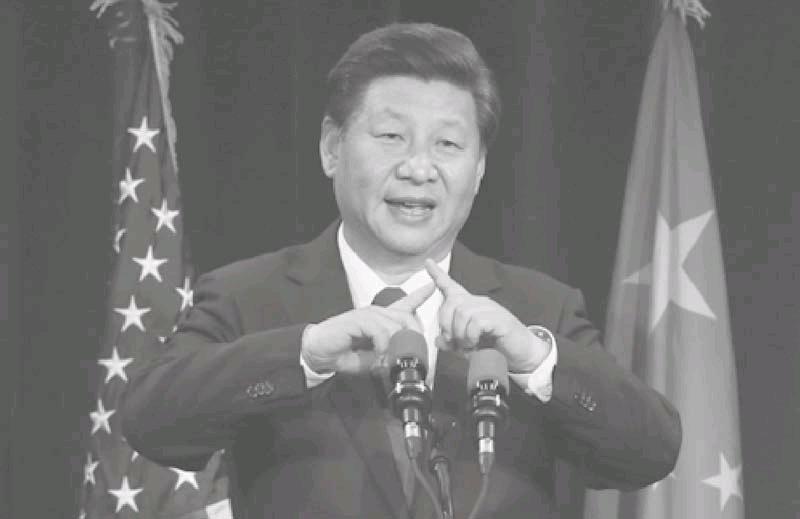China’s Economic Catch-up Zero-sum Game or Bigger Cake for U.S.?
From promoting clean energy and developing fourth-generation nuclear power to buying 300 Boeing aircraft and launching more Boeing plants in China, and to encouraging cooperation of Internet companies and investing more in the United States: China is deepening its economic and trade ties with the U.S. as a slew of business deals are reached during Chinese President Xi Jinpings recent visit to the U.S., proving that a powerful Chinese economy is a bless to the U.S. instead of a threat.
Growing Economic Comple-mentarily
“There are strong economic complementarily between China and the United States due to their different development stages. And there are broader space for economic and trade cooperation and more opportunities,” Xi said at a China-U.S. entrepreneurs forum on Sept. 23, indicating that the deepening China-U.S. economic cooperation is upgrading and expanding into new areas.
Cooperation in energy sector is a prominent feature in the agreements signed during Xis visit. During talks with U.S. governors, Xi witnessed the signing of a deal on clean energy and climate change. Also remarkable is the fourth-generation nuclear power exploitation agreement signed by China National Nuclear Corporation and TerraPower, an energy company founded by Bill Gates.
There is also bountiful achievement in aviation and Internet Sector. The most watched is the announcement of Boeing to acquire orders from Chinese companies during Xis visit to its factory. Boeing chief executive officer Dennis Muilenburg said that the company is very proud to expand business in a new mutually beneficial cooperative way and that China is Boeings largest international market.
Microsoft has a history of 20 years of development in China. At the China-U.S. Internet forum, Microsoft has signed cooperative agreements with China Electronics Technology Group Corporation, Unisplendour Corporation Limited, 21 Vianet Group and Baidu.
Moreover, Cisco will invest 100 million U.S. dollars to establish a joint venture enterprise in China together with Inspur Group. Didi Taxi signed strategic cooperative accords with its U.S. counterpart Lyft and LinkedIn, the largest professional social platform in the world.
Mei Xinyu, international trade and economic cooperation researcher at the Chinese Commerce Department said that the Internet and energy sectors represent the new trend of economic complementarility between China and the United States. In Internet sector, China-U.S. cooperation is already profound with big-scale Chinese Internet companies listed in the U.S. and China being the largest E-commerce market in the world. As to Internet safety, he said, China and the U.S. may reach the first “Internet Disarmament Agreement,”which means significantly to the professional rules.
Mei said that China and the U.S. are the two countries with the largest volumes of energy consumption and imports in the world. The U.S. will soon become a net exporter of petroleum and natural gas while China will turn into the worlds largest net importer of energy. In such context, China-U.S. cooperation will have a profound impact on the world energy market.
Early this year, U.S. economist and Nobel economic prize winner Joseph Stiglitz wrote an article titled The Chinese Century in Jan. issue of Vanity Fair, pointing out that Chinas economic growth is complementary to the U.S. instead of being exclusive, leading to more consumption of U.S. products and bring prosperity to the country.
Former U.S. treasury secretary Henry Paulson recently wrote in the Washington Post that from agribusiness to medical devices, the U.S. and Chinese economies are increasingly complementary, and both U.S. and Chinese companies need expanded opportunities in each others markets.
Win-win Nature
As President Xi reiterated during his visit to the United States, China-U.S. economic and trade relations are essentially mutually beneficial, which is confirmed by the increasing interdependence of the two big growing economies.
In terms of trade, China and the United States have become each others second largest trade partner, and China has become Americas fastest growing export market as well. According to a U.S.-China Business Council report, in the past ten years, U.S. export to China surged 255 percent with the average annual growth rate up to 15.1 percent, and 42 U.S. states have listed China among their top three export markets, which indicates that the Chinese market has been playing a more and more important role in boosting the U.S. economic growth and job creation.
As to investment, the main China-U.S. investment relation has been transformed to the current two-way investment flows from the previous one-way U.S. to China investment, and China has become one of Americas fastest growing source of foreign direct investment.
According to the U.S. Department of Commerce, from 2009 to 2013, the average annual compound growth rate of Chinas direct investment to the U.S. reached around 41 percent. At present China and the U.S. are in bilateral investment treaty negotiations, and once done it will provide more opportunities for enterprises of both countries. Think-tanks of both countries also suggest that China and the United States should study the feasibility of a bilateral trade agreement, which shows huge potential and broad prospect in China-U.S. economic and trade cooperation.
Another classic example of China-U.S. high economic interdependence is that China has already become an important force to create jobs in the United States.
According to a report jointly released by the National Committee on U.S.-China relations and Rhodium Consulting Group in the United States, over the past 15 years, Chinas total direct investment to the United States reached 46 billion U.S. dollars, with more than 80,000 American jobs created by China at present. Now, the United States has become Chinas third largest destination of foreign direct investment. Chinas direct investment to the United States is just in its initial stage. It s expected to reach 100 billion to 200 billion U.S. dollars by 2020 if growth trends continue.
Mutually Beneficial
Recently, the world has been closely following such hot financial topics as the quota and governance reform of the International Monetary Fund (IMF), the establishment of BRICS New Development Bank, Asian Infrastructure Investment Bank (AIIB) and the Belt and Road Initiative.
These regional financial institutions and trade arrangements proposed by China do not intend to replace existing regional cooperation mechanisms and proposals, but are rather beneficial supplements to the current global economic order and valuable explorations aiming at improving global economic governance system.
For instance, China and the United States had, after many rounds of consultation, reached consensus on expanding the scope of their Information Technology Agreement (ITA) at the end of 2014, which will contribute to promoting global trade and development in the IT industry, thus raising public confidence in the multi-lateral trade system.
Currently, while the United States is taking the lead in advancing talks on the Trans-Pacific Partnership (TPP), China and the Southeast Asian nations are jointly promoting negotiations on the Regional Comprehensive Economic Partnership(RCEP).
Although there are tremendous differences in the content and among the participating members of the two regional trade talks, all parties do share the same goal of building a free trade zone in the Asia Pacific region that will ultimately lead to trade liberalization.
This means that China and the United States can cooperate in finding ways to integrate TPP and RCEP under the framework of an Asia Pacific free trade zone so as to avoid conflicting rules or fragmentation.
Fred Bergsten, senior fellow of Peterson Institute of International Economics, thinks that in the end, China, the United States and Japan as the worlds top three economies will all be included in an Asia Pacific free trade zone, for no regional trade arrangement will be complete or successful without the three nations participation.
Based on that, he thinks the United States and Japan will eventually join the China-proposed AIIB.
Bergstens estimate is justifiable by the fact that with more and more Western powers applying for membership in the AIIB, the United States has gradually changed its opposing attitudes toward the AIIB, emphasizing that the AIIB could cooperate with existing multi-lateral development institutions like the World Bank, adopt the same governing and operating standards and constitute complimentary relations.
“The China-U.S. economic relationship is mutually beneficial, not a zero-sum game,” said Li Shengjiao, a senior Chinese diplomat and columnist of the Huffington Post, adding that Chinas prosperity does not come at the expense of the United States.
“Rather, the rise of a prosperous China is in Americas and the worlds best interests, as Obama himself put it,” he said.

